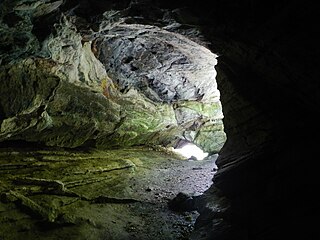Gudenus Cave
| Gudenus Cave
|
||
|---|---|---|
| Location: | Kremstal , Hartenstein rock face | |
| Height : | 496 m above sea level A. | |
|
Geographic location: |
48 ° 26 '50 " N , 15 ° 23' 45" E | |
|
|
||
| Cadastral number: | 6845/10 | |
| Geology: | marble | |
| Type: | Passage cave | |
| Overall length: | 30 m | |
| Level difference: | 4 m (+3 m, −1 m) | |
| Particularities: | Archaeological site | |
The Gudenus Cave in northwestern Lower Austria was frequented by a group of Neanderthals 70,000 years ago and is one of the most important Stone Age sites in Central Europe .
Surname
The cave is named after the former noble family of Gudenus , who are still living in Albrechtsberg an der Große Krems , locality Els, today . The former owner of Hartenstein Castle and the owner of the area around the Gudenus Cave was baron Heinrich von Gudenus, who promoted and permitted the first excavations in the cave.
location
The cave is 7.5 meters above the Kleine Krems north of the Wachau , a breakthrough valley of the Danube . The small Kremstal runs between the Großer Krems and the Danube and has cut deeply into the low mountain range there , which reaches a height of approximately 800 meters parallel to the Wachau. The cave is located 15 kilometers west of the city of Krems , directly below Hartenstein Castle in a rock near the shore.
description
The Gudenushöhle is a 30 meter long passage cave with two entrances and a day opening. It runs in an arch between the two entrances. The rooms of the cave are on average four meters wide and up to three meters high. In the east there is still a small side niche. Today the cave has been cleared down to the rock floor by excavations.
meaning
Around 70,000 years ago, Neanderthals hunted cave bears , mammoths , reindeer , wild horses and woolly rhinoceros here . Also, uniquely for Austria, a reassessment of the finds in the 1990s revealed bones of the saiga antelope ( Saiga tatarica ). In the lower cultural layer of the cave, hand axes , scrapers and processed animal bones were found, among other things , which are assigned to the Moustérien . The upper cultural layer from Magdalenian (approx. 18,000–10,000 BC) brought a bone pipe to light. Along with the bone flute from the Grubgraben near Kammern, this is one of the oldest musical instruments in Austria. An eagle bone with an incised reindeer head was also found.
tourism
In the vicinity of the Gudenus Cave, a geological nature trail explains the formation of the limestone and marble rocks as well as the mountain formation and granites of the Waldviertel . There are more water games for children at the Kleine Krems. The hiking trail (not a cycle path ) to the Gudenushöhle begins at the Maigen mühle between Albrechtsberg and Weinzierl am Walde .
See also
literature
- Robert Bouchal, Josef Wirth: Cave Guide Austria - Over 100 caves with sketches, plans, access descriptions and 150 photos . Pichler Verlag, Vienna 2001, ISBN 3-85431-234-2 , pp. 90-94.
- Helga and Wilhelm Hartmann: The caves of Lower Austria . In: Regional Association for Speleology in Vienna and Lower Austria (ed.): Scientific supplements to the magazine "Die Höhle" . tape 5 . Vienna 2000, p. 499-500 .
- Helga and Wilhelm Hartmann: The caves of Lower Austria . In: Regional Association for Speleology in Vienna and Lower Austria (ed.): Scientific supplements to the magazine "Die Höhle" . tape 3 . Vienna 1985, p. 339-345 .
- Helga Hartmann, Wilhelm Hartmann: The caves of Lower Austria . Volume 3: Southwestern Lower Austria and peripheral areas, Waldviertel . Vienna 1985, pp. 339-345.
Web links
- Gudenushöhle, municipality of Albrechtsberg / Lower Austria
- Bone pipe from the Gudenus cave
- Chauvet / C14, Neanderthal art 30,000 years ago

